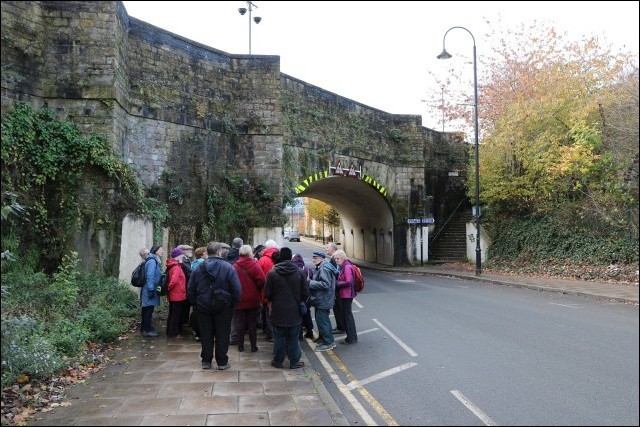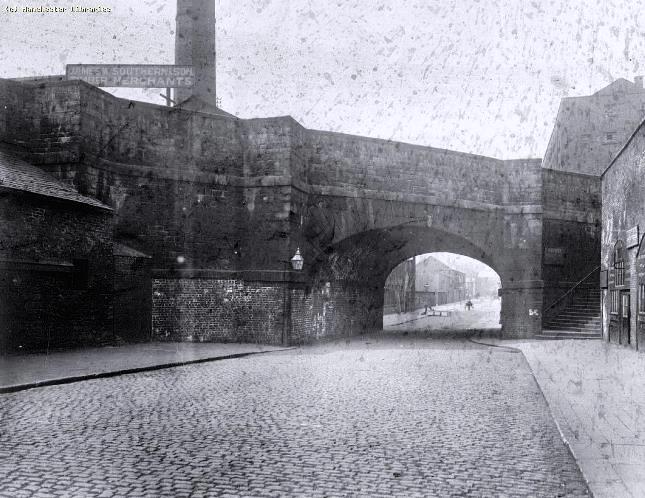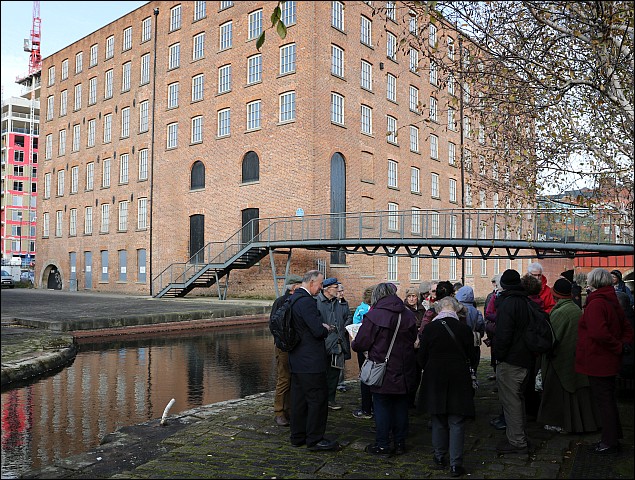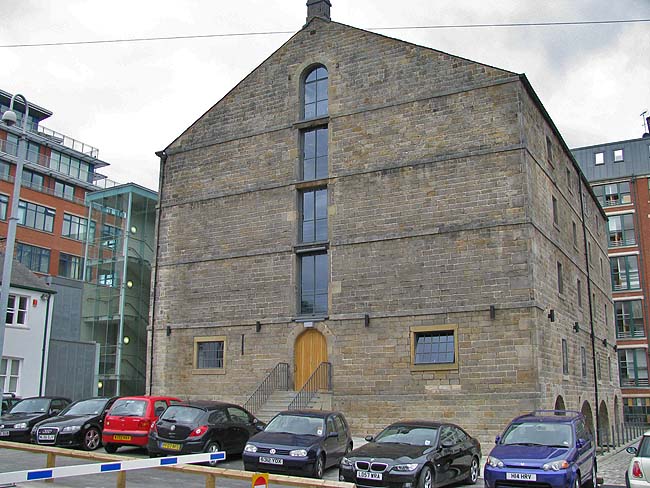
‘Ancoats ... is to Manchester what Manchester is to England’
Morning Chronicle, 21 December 1849
Manchester’s Ancoats area formed the destination of the second al-fresco autumn outing for the society members. Led by Mark Watson, of the Manchester Victorian Society, we enjoyed a two hour Ancoats tour, in the morning, with thirty one participants; the afternoon optional walk drew seven of the thirty one.
In a little over 50 years, from th e late 18th century, a rural landscape on the eastern outskirts of Manchester was transformed into the most densely packed industrial landscape in the world. As a pioneer industrial suburb, Ancoats holds a unique place in industrial and social history.
e late 18th century, a rural landscape on the eastern outskirts of Manchester was transformed into the most densely packed industrial landscape in the world. As a pioneer industrial suburb, Ancoats holds a unique place in industrial and social history.
Mark (in the red coat, left) met us on the Piccadilly Station, to begin the morning’s exploration. We were first guided outside to a quieter spot, overlooking London Road. Mark gave a synopsis of the station’s history, from steam to electric, from London Road to Piccadilly. We then descended into the lower reaches of the station, the undercroft and the adjacent brick pillared car park. It was while in the latter, in the midst of its brick splendour, that we were ushered off the site by a very keen car park attendant. We had apparently wandered into a ‘restricted area’, though Mark had had verbal clearance to venture there. This area was used as a goods station, in the past. Its cast iron columns and brick arches support the non-through platforms in the station.

To Store Street to view the aqueduct, built in 1796 to the design of Benjamin Outram. Grade II* listed building it is built on a skew of 45° across Store Street, it is believed to be the first major aqueduct of its kind in Great Britain and the oldest still in use today. (right) Outram also found employment when the Peak Forest was constructed, as the resident engineer. In nearby Sparkle Street, Mark related that the area, if not the street, was mentioned in Elizabeth Gaskell’s ‘Mary Barton’. Very few buildings of that book’s vintage still stand in this area, the history lies deep underground beneath two centuries of development.
Paradise Wharf was reached next, via steep stone steps and a rising ramp. Mark commented on the apparent delight that the powers in Victorian times took in the naming of areas and streets, Paradise Wharf indeed! To slake the thirst of the wharf workers the Jolly Angler stood nearby, and is now one of the oldest pubs in the city. The Angler does not appear on a 1849 map; instead, on the corner of what was then Mather Street and Pidgeon Street was the Mather Street School (Independent Sunday), adjoining the Good Samaritans Total Abstinence Hall. Abstinence followed by alcohol!
We then paraded onto Great Anco ats Street, making a stop by the Rochdale Canal Bridge, to learn the history of the Manchester's Brownsfield Mill building (left) which stood before us. Contained within this mill was the first Avro aircraft plant, founded by pioneering aeronautical engineer, Alliott Verdon-Roe in the premises that were then owned by his brother Humphrey. Together they formed A.V. Roe & Company (Avro) — the world's first company registered solely as a manufacturer of aircraft. This Grade II*historic mill is now being developed into apartments. At the time of the factory Humphrey was living in Arkwright Road in Marple with his aunt. The morning’s walk drew to conclusion, after walking down the cobbled towpath towards the centre of the city. The most noteworthy building in this area is, for the Marple visitors, the Dale Street warehouse. The Dale or Carver’s warehouse (below) was the first warehouse built on the Rochdale Canal, at the head of what was then the Piccadilly Basin. Four stories, with an attic and cellar it was built from water-shot stone. This was a style of building that tilted the stone courses to help the water drain away. The morning drew to a close, at which point, Mark our guide, offered the option of another stroll through Ancoats.
ats Street, making a stop by the Rochdale Canal Bridge, to learn the history of the Manchester's Brownsfield Mill building (left) which stood before us. Contained within this mill was the first Avro aircraft plant, founded by pioneering aeronautical engineer, Alliott Verdon-Roe in the premises that were then owned by his brother Humphrey. Together they formed A.V. Roe & Company (Avro) — the world's first company registered solely as a manufacturer of aircraft. This Grade II*historic mill is now being developed into apartments. At the time of the factory Humphrey was living in Arkwright Road in Marple with his aunt. The morning’s walk drew to conclusion, after walking down the cobbled towpath towards the centre of the city. The most noteworthy building in this area is, for the Marple visitors, the Dale Street warehouse. The Dale or Carver’s warehouse (below) was the first warehouse built on the Rochdale Canal, at the head of what was then the Piccadilly Basin. Four stories, with an attic and cellar it was built from water-shot stone. This was a style of building that tilted the stone courses to help the water drain away. The morning drew to a close, at which point, Mark our guide, offered the option of another stroll through Ancoats.
The Secret Seven reassembled at one-thirty and started an exploration of the lower reaches of the Ashton Canal. As we did so we passed over the Store Street aqueduct. To our left we could see one of the few remaining industrial sites in the central Manchester, occupied by Presbar Castings. This company’s buildings reside on a site upon which once stood the engineering works of William Fairbarn, the 1st Baronet of Ardwick. One notable product of the factory was the 338 ton Albert Hall roof. A trial erection was made in the factory; this being successful, it was dismantled and transported to London. On 11 May 1869, after evacuating Albert Hall, the engineers stood at the top of scaffolding and knocked the props supporting the dome away; incredibly the dome dropped just 5/16” before settling into position on the supporting walls of the Hall, where it has remained ever since.
The day drew to a close for the remnants of the morning group. Our sincere thanks were given to Mark, who had been with us for nigh on five hours, poor chap. Our thanks also go to Judith Wilshaw for arranging this dip into Manchester’s history.
Photos: Bill Beard, David Burridge and from the Manchester Image Archive
Article: Martin Cruickshank
















